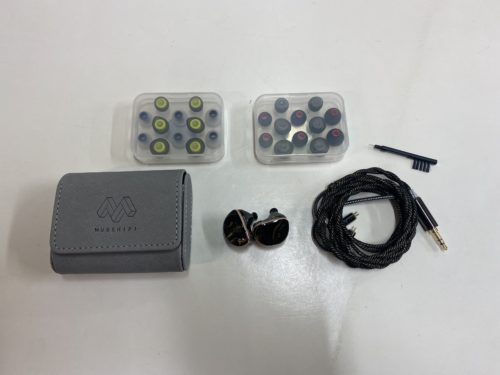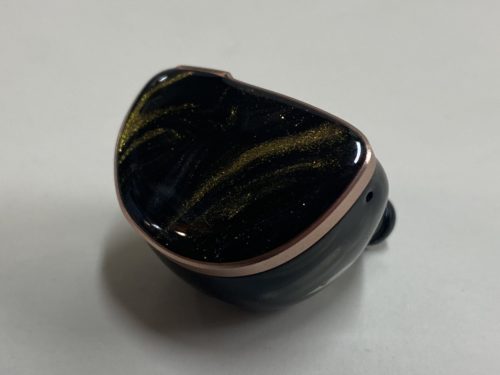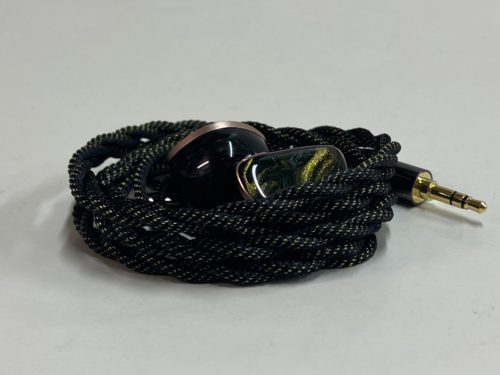Planar IEMs are starting to pop up more regularly in recent times. The 7 Hertz Timeless has proved to be one of the most popular budget options, but it is not the only one. I have not been familiar with MUSE HiFi before I got a chance to listen to their Power model, but with this $199 planar model, let’s see if they can get on our radar.
What You Get
- Storage box
- 2-pin 3.5mm cable
- 4 sets of ear tips
- 3 pairs of EQ tips
- 3 pairs of vocal tips
- 3 pairs of sound field tips
- 3 pairs of high-end tips
- Manual
Look and Feel
I was surprised to see how big the Power was when I took them out of the box. It has a pretty sizable housing and comes with a beautiful faceplate design reminiscent of the ultra-high-end Sultan from Noble Audio. The glittery golden swirls are easy to fall in love with, giving you preconceived notions about the Power’s quality before you even have a chance to listen to it. If the size of the Power has you worried about the fit, I think you can put those worries to rest. I have pretty big ears, but the housing is weightless and has a solid level of support and comfort. Its outer sell is sustained greatly by the earphones nozzles, firmly grasping your inner ear without any added pressure.
Design
The Power uses a flat diaphragm for its 14.5mm planar magnetic driver. Special acoustic chambers are implemented to lower distortion and preserve the integrity of the output signal, while also helping distribute pressure. Its stock cable is a high purity Litz with crystal copper cores and coaxial shielding for a more robust build.
- Frequency response range: 10Hz-40kHz
- Impedance: 32Ω
- Sensitivity: 106dB
Soundstage
A planar IEM comes with some form of excitement since they are such a rare breed. Sonically, we expect some major differences between a planar and dynamic driver, and that soundstage is a good place to showcase that distinction. For the Muse, the soundstage has a great width, presenting left and right positioning on a leveled ground that expresses their spacing nicely. You get an outward presence that gives the layering a bit of depth, with good separation that better articulates those layers. I didn’t feel much wrap around on this stage, but as a stereo field, the Muse comes together clearly.
Low End
This IEM shines in its bass frequencies, which deliver the goods in terms of impact and drive. They receive just the right amount of gain for the exact profile Muse is going for, and the tone is granted enough meat to extend its response to fulfill that profile. It is helped by a subtle but completely effective sub-bass texture that brings out the lows to a much broader space. In effect, it creates a powerful rumble that not only feels gripping but controlled, centering itself in a space that feels appropriate for them to be in. You’ll never hear the bass be consumed by boominess, as it swaps out overemphasis for precision and clarity.
Mids
The mids do a good job balancing themselves with the rest of the sound signature, giving a fast and accurate timbre to these frequencies. For the price, the midrange offers some satisfying detail retrieval, as instruments and vocals are brought to life in a way that seems unique for an IEM of this type. While they aren’t given the same treatment in terms of power as the bass, the mids still provide clarity in a well-defined form. The low and high mids seem to be favored in terms of gain, but it doesn’t leave areas for notches, which leads to interesting complexities in vocals and instruments to be shown. For instance, the way vocals take a forward stage in the mix offers height and a bit of crispness to their timbre as a whole. The rattling of strings offers a similar type of transparency, establishing a certain sense of weight on some tracks.
Highs
The treble region has a great sheen to it, as the timbre fixates on the delicateness of its response in trade for extended brightness. In certain moments the high frequencies have the opportunity to extend themselves into some piercing textures, but it never comes off as harsh. Instead, their tone is deeply resolving, delivering a feeling of bite with its ringing response. This blend brought me some great enjoyment when listening to many different tracks, as their crisp tone became a real highlight for me. I like hearing the hiss of certain tracks sometimes and the Muse delivered that to me in droves.
Summary
I found a lot to enjoy about the Power planar IEMs from MUSE HiFi. For the price, it is really hard to find anything major to criticize as a flaw. The size of the shell might deter some from thinking the Power will be comfortable to wear, but the eye-catching design still might make you think twice. As for the sound signature the bass and highs are its biggest strength, with the mids not far behind in its ability to display exciting details. At $199, this planar IEM is not one to miss out on.
| Pros | Cons |
| · Wide soundstage
· Impactful bass · Clear mids · Defined treble · Beautiful design · Good cable · Price |
· Housing might be too big for certain people |
The MUSE HiFi Power Planar IEM is available for pre-order at Audio46.
Compare the ranking of various headphones, earbuds and in-ear monitors using our tools.
Discuss this, and much more, over on our forum.
---MAJORHIFI may receive commissions from retail offers.



















